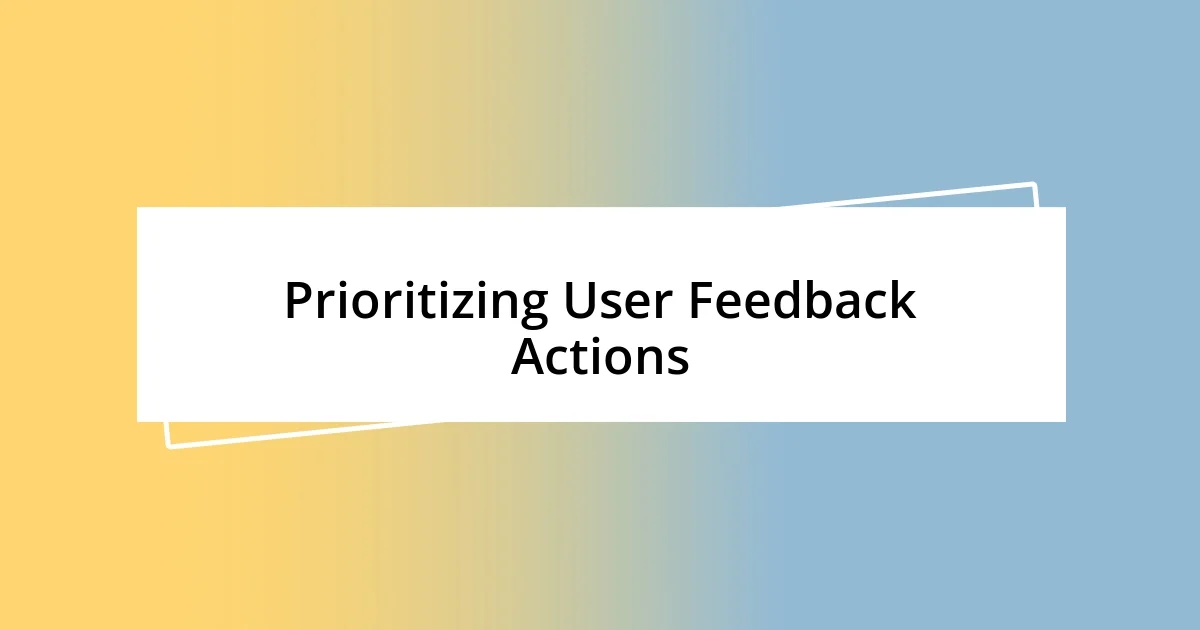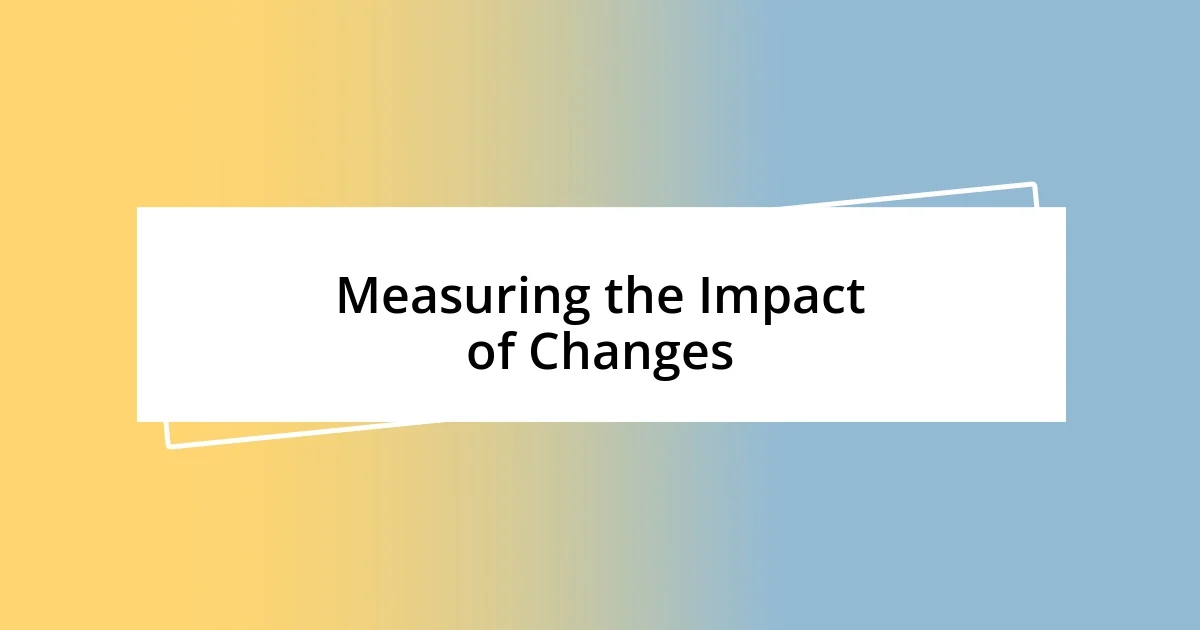Key takeaways:
- User feedback is essential for product improvement; it fosters empathy and strengthens user relationships.
- Effective feedback gathering involves diverse methods, such as surveys, interviews, and usability testing, combined with a systematic prioritization process.
- Continuous engagement with users, through direct communication and feedback sessions, turns users into advocates and enhances the community around the product.

Understanding User Feedback
User feedback is like a treasure map leading to insights we might overlook. I vividly remember a project where we revamped a feature based on user comments. The moment we implemented those changes, I could feel the excitement in the air—users felt heard, and it transformed our relationship with them.
Listening to user feedback often feels like opening a window to their world. Have you ever received a suggestion that completely shifted your perspective? I once encountered feedback that pointed out user confusion with our navigation. It struck me because I realized how easy it is to forget what it feels like to be a newcomer. The experience highlighted the importance of empathy in understanding their journey.
Embracing user feedback is crucial for growth, but it’s essential to analyze it thoughtfully. Not every comment requires action, but each offers a glimpse into our users’ experiences. I’ve often found that diving deep into feedback can reveal trends that we might have otherwise missed, allowing us to make informed decisions that resonate with our community.

Gathering User Feedback Effectively
Gathering user feedback effectively requires a multi-pronged approach. In my experience, different methods yield unique insights. For instance, while surveys offer quantitative data, one-on-one interviews often reveal the emotional undercurrents behind user experiences. I recall a time when a casual chat with a user unveiled frustrations that a survey simply wouldn’t have captured. Those subtle nuances can truly shape how we refine our offerings.
Moreover, utilizing tools like usability testing can illuminate pain points within your interface. I’ve sat through countless testing sessions, observing users interact with our product. It’s a fascinating experience—their expressions, hesitations, and questions tell stories that numbers on a page never could. Have you noticed how a user’s facial expression can often convey far more than their words? That’s why I find it invaluable to combine visual cues with verbal feedback.
To streamline the feedback process, I always suggest prioritizing feedback channels. For instance, categorizing comments based on urgency or relevance can help determine what to address first. I had quite a learning curve in this area; initially, I tackled feedback in a random order, and it felt overwhelming. Once I organized it, I noticed not only efficiency but also a boost in user satisfaction as we addressed their concerns more systematically.
| Method | Description |
|---|---|
| Surveys | Collect quantitative data on user satisfaction and preferences. |
| User Interviews | Engage in deeper one-on-one discussions for qualitative insights. |
| Usability Testing | Observe user interactions to identify pain points in real-time. |
| Feedback Prioritization | Organize feedback based on urgency and relevance for effective action. |

Analyzing User Feedback Trends
Analyzing user feedback trends allows us to step beyond surface-level observations and truly understand the underlying themes driving user sentiments. I recall a time when I sifted through a year’s worth of feedback and noticed a recurring mention of “loading times.” The trend was subtle but telling—users were not just frustrated; they felt their time was undervalued. This realization guided our tech team to prioritize backend improvements, ultimately leading to enhanced user satisfaction and engagement.
To effectively analyze these trends, I often rely on methods that can translate qualitative insights into measurable data points. Here’s how I approach it:
- Thematic Analysis: I categorize comments into themes. For instance, if multiple users mention difficulties with onboarding, it signals a need for better guidance.
- Sentiment Analysis: I utilize tools to gauge the emotional tone of feedback. A simple thumbs-up may carry less importance than a shaken fist when users describe their struggles.
- Trend Visualization: Creating visual representations of feedback patterns helps spot spikes in particular issues. I love using graphs—seeing data visually often ignites new ideas.
By refining my approach to analyzing user feedback, I ensure that I not only acknowledge users’ voices but also leverage those insights into actionable strategies. It’s that transformation from data to real change that excites me.

Prioritizing User Feedback Actions
The process of prioritizing user feedback actions can sometimes feel like navigating through a maze. I’ve found that using a scoring system, where we assign values to feedback based on factors like urgency and impact, helps clarify our path. I once implemented this system after feeling overwhelmed by countless comments; it allowed my team to see the bigger picture and act on what truly mattered to our users.
Additionally, I believe it’s vital to involve different team members in the prioritization process. Collaborating with colleagues from various departments—like marketing and design—can unveil insights that I might overlook. During one planning session, I was surprised when a designer highlighted a technical issue that several users had pointed out, ultimately influencing our development roadmap. Isn’t it fascinating how diverse perspectives can lead to more informed decisions?
Lastly, showing users that their feedback drives change can strengthen their loyalty. When I took the time to personally reach out to users who suggested impactful ideas, the responses were overwhelmingly positive. It made them feel valued, turning their frustration into a sense of partnership. It begs the question: how often do we tell our users their voices matter? Strengthening that connection not only propels our projects forward but nurtures a community around our brand.

Implementing Feedback into Development
Integrating user feedback into the development process is like weaving a tapestry of insights into the fabric of our product. I recall a project where, after a user survey, it became clear that our mobile app’s navigation needed refinement. Seeing the frustration expressed in several comments, I felt an urgency to act. It was empowering to gather our development team and brainstorm ways to streamline the interface. We didn’t just fix the navigation; we transformed the entire user experience, which led to a noticeable spike in active users.
In my experience, open communication between teams is crucial during this integration phase. I remember introducing regular feedback meetings that included not only developers but also customer support and marketing. This collaboration brought to light concerns I hadn’t considered. For instance, the support team shared instances where users struggled; those insights sparked solutions that made our updates even more robust. Doesn’t it make sense that the more voices we include, the more holistic our solutions become?
I’ve learned that the key is not just implementing feedback but also tracking its impact. After we rolled out changes based on feedback, I set up metrics to measure user engagement post-implementation. There’s something profoundly gratifying about seeing those numbers improve. It’s like hearing a chorus of users cheer from the crowd after a successful performance. Reflecting on the journey, I often ask myself: how can we keep this momentum going? It drives me to not just listen more attentively but to anticipate needs before they’re explicitly voiced.

Measuring the Impact of Changes
Measuring the impact of changes after implementing user feedback is an eye-opening experience. I recall rolling out a new feature in response to user suggestions and eagerly awaiting the data. The moment I saw a 30% increase in user retention, I couldn’t help but feel a rush of excitement. It reaffirmed my belief that listening and adapting to our users truly pays off.
Equally important is understanding how to interpret those metrics. Early on, I made the mistake of celebrating numbers without digging deeper. After noticing a significant spike in engagement, I soon realized that user sessions were shorter than expected. This prompted me to ask, “What’s missing?” I initiated follow-up surveys, which revealed that while users loved the new feature, they found it difficult to integrate it into their routine. It’s those moments of revelation that truly shape our path moving forward.
I believe it’s vital to share these insights with our entire team. When I started presenting user feedback metrics in our review meetings, I saw a shift in morale and motivation. Team members were no longer just developers; they were now part of a mission to improve real people’s experiences. Isn’t it fascinating to think that our numbers have faces, stories, and emotions behind them? This connection fuels our drive to innovate continuously, ensuring we’re not just evolving our product but also deepening our relationship with our users.

Continuously Engaging with Users
Engagement doesn’t stop after implementing changes; it’s an ongoing relationship that needs nurturing. I remember hosting weekly feedback sessions where users could openly express their thoughts about the app. The energy in those meetings was electric! Hearing users share their experiences made me feel connected to them in a way that data alone could never achieve. Isn’t it fascinating how the words of a single user can spark ideas and strategies we hadn’t even considered?
I’ve also found that proactively reaching out to users creates a sense of community around the product. For instance, I initiated a monthly newsletter that not only outlined updates but also featured user success stories. I was surprised at how many people responded, sharing their journeys and how our app influenced them. No longer were they just users; they became advocates who felt invested in our mission. This two-way communication transforms our approach, making it feel less transactional and more collaborative.
What I’ve learned through this process is the importance of genuine interactions. I recall a particularly tough week when user stories revealed serious pain points in our app. Instead of retreating, I decided to host a live Q&A session with the users. It was scary, but connecting directly with them brought about an unexpected wave of support and understanding. Their willingness to give feedback face-to-face reminded me that our users care deeply about our product and want it to succeed. How can we not respond to that kind of passion?














